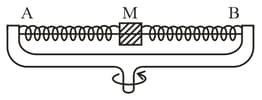A uniform rod is placed on two spinning wheels as shown in figure. The axes of the wheels are separated by a distance , the coefficient of friction between the rod and the wheels is, . Demonstrate that in this case the rod performs harmonic oscillations. Find the period of these oscillations. Take



Important Questions on OSCILLATIONS AND WAVES
the equation of motion of a body falling down into the shaft,
how long does it take the body to reach the other end of the shaft,
the velocity of the body at the Earth's centre.
Find the period of small oscillations of a mathematical pendulum of length if its point of suspension moves relative to the Earth's surface in an arbitrary direction with a constant acceleration as shown in the figure. Calculate that period if and the angle between the vectors and equals .

In the arrangement shown in the figure, the sleeve of mass is fixed between two identical springs whose combined stiffness is equal to . The sleeve can slide without friction over a horizontal bar . The arrangement rotates with a constant angular velocity about a vertical axis passing through the middle of the bar. Find the period of small oscillations of the sleeve. At what values of will there be no oscillations of the sleeve?

(a) was deviated through the angle and then, set free without push,
(b) was in the equilibrium position and its lower end was imparted the horizontal velocity ,
(c) was deviated through the angle and its lower end was imparted the velocity directed to ward the equilibrium position.
A body of mass and a body of mass are interconnected by a spring, as shown in the figure. The body performs free vertical harmonic oscillations with amplitude and frequency . Neglecting the mass of the spring, find the maximum and minimum values of force that this system exerts on the bearing surface. Take .

A plank, with a body of mass placed on it, starts moving straight up, according to the law where is the displacement from the initial position, . Take . Find:
(a) the time dependence of the force that the body exerts on the plank, if , plot this dependence,
(b) the minimum amplitude of oscillation of the plank at which the body starts falling behind the plank,
(c) the amplitude of oscillation of the plank at which the body springs up to a height , relative to the initial position (at the moment ).
(a) the law of motion where is the displacement of the body from the equilibrium position,
(b) the maximum and minimum tensions of the spring in the process of motion.
